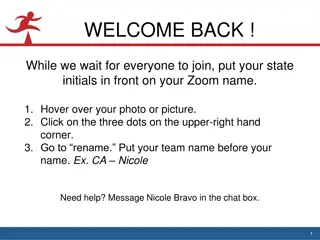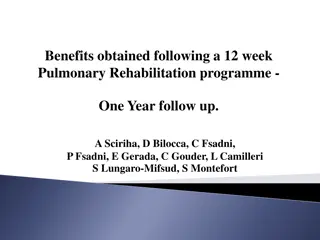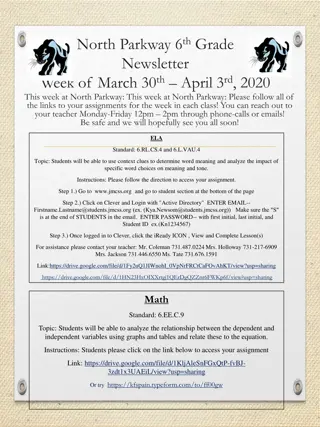
Cipher Techniques and Encryption Methods Explained
Delve into the world of cryptography with a focus on transposition and shift ciphers. Learn how to manipulate strings, utilize ord() and chr() functions, and apply shift encryption techniques. Discover the art of converting characters to ASCII values and back, all while exploring the history of these encryption methods, famously used by Julius Caesar. Unravel the algorithm behind shift encryption and enhance your understanding of data security.
Download Presentation

Please find below an Image/Link to download the presentation.
The content on the website is provided AS IS for your information and personal use only. It may not be sold, licensed, or shared on other websites without obtaining consent from the author. If you encounter any issues during the download, it is possible that the publisher has removed the file from their server.
You are allowed to download the files provided on this website for personal or commercial use, subject to the condition that they are used lawfully. All files are the property of their respective owners.
The content on the website is provided AS IS for your information and personal use only. It may not be sold, licensed, or shared on other websites without obtaining consent from the author.
E N D
Presentation Transcript
What did we talk about last time? Looping over strings Cryptography Transposition cipher Shift cipher ord() and chr() functions
We can convert a string with a single character in it into the integer that represents it with the ord() function number = ord('a') # number contains 97 If you know the numerical value of a character, you can convert that number back into a string using the chr() function letter = chr(100) # letter contains 'd'
A shift cipher encrypts a message by shifting all of the letters down in the alphabet Using the Latin alphabet, there are 26 (well, 25) possible shift ciphers We can model a shift cipher by thinking of the letters A, B, C, Z as 0, 1, 2, 25 Then, we let the key k be the shift For a given letter with value x: encrypt(x) = (x + k) mod 26
A B C D E F G H I J K L M N O P Q R S T U V W X Y Z D E F G H I J K L M N O P Q R S T U V W X Y Z A B C E("KILL EDWARD") = "NLOO HGZDUG" What is E("I DRINK YOUR MILKSHAKE")? What is D("EUHDNLWGRZQ")? This code was actually used by Julius Caesar who used it to send messages to his generals
Algorithm: Loop over all characters Convert character to ASCII value Convert ASCII value to a value from 0-25 by subtracting the value of 'A' Add the key to the result Compute the result modulus 26 (which makes numbers bigger than 25 wrap around) Add back the value of 'A' to turn a value from 0-25 back into an ASCII value Turn the ASCII value back into a character and concatenate it onto the ciphertext Return the ciphertext def shiftEncrypt(plaintext, key):
Reversing the process to decrypt the ciphertext is simple All we need to do is "encrypt" the ciphertext with the negation of the key we used to encrypt For example, if we encrypted with a key of 7, we can decrypt by encrypting with a key of -7 Our decrypt function should simply call the encrypt function with a negative key def shiftDecrypt(ciphertext, key):
Our implementation expects all input characters to be from 'A' up to 'Z' That's why subtracting ord('A') will make the values be between 0 and 25 Inputting strings that contain characters other than uppercase letters (e.g. digits, lowercase letters, punctuation) will cause strange results
Substitution ciphers cover a wide range of possible ciphers, including the shift cipher In a substitution cipher, each element of the plaintext is substituted for some corresponding element of the ciphertext Monoalphabetic substitution ciphers always use the same substitutions for a letter (or given sequence of letters) Polyalphabetic substitution ciphers use different substitutions throughout the encryption process
We can map to a random permutation of letters For example: A B C D E F G H I J K L M N O P Q R S T U V W X Y Z I N O V Z H A P T R G E U F D W S B Q Y L K M J C X E("MATH IS GREAT") = "UIYP TQ ABZIY" 26! possible permutations Hard to check every one
A B C D E F G H I J K L M N O P Q R S T U V W X Y Z I N O V Z H A P T R G E U F D W S B Q Y L K M J C X Using the same mapping, perform the following encryption: E("HELP ME") = Perform the following decryption: D("VD CDL QZZ YPZ HFDBV") =
Algorithm: Loop over all characters Convert character to ASCII value Convert ASCII value to a value from 0-25 by subtracting the value of 'A' Use this value as an index into the scrambled key alphabet Concatenate the character at this location onto the ciphertext Return the ciphertext def substitutionEncrypt(plaintext, key):
Our version of the substitution cipher is different from the book's We only use uppercase letters We don't have a space We don't have to use the find() function But it's a good idea to learn about find() on your own
One of the annoying things about using a substitution cipher is that you have to come up with a permutation (a scrambling) of the alphabet But Python can help us do that!
First, we need a function that: Takes a string and an index Returns a new string with that index removed In other words, we return the string with all the characters before the index concatenated to all the characters after the index We can do that in a single line of Python def removeChar(string, index):
Algorithm: Create a string that holds all the characters of the alphabet Loop as many times as the length of the alphabet: Pick a random integer between 0 and the remaining length of the alphabet Put the character at that location at the end of the key we're making Use removeChar() to remove the character at that location from the alphabet Return the key def makeKey():
Vigenre cipher Work time for Assignment 3
Read Section 3.7 of the textbook Work on Assignment 3






















